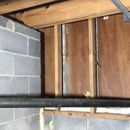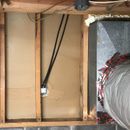Canned Spray Foam Insulation in Crawlspace Stud Bay?
Thanks in advance for the help. I have read every article and comments I can find related to my situation, but still need some direction.
Climate Zone 4A. House built into hill.
Half of the home is on slab/some sort of foundation, and half is on a crawlspace that is partially below grade. Crawlspace has 3 cinderblock walls, and 4th wall connects the two parts of the home: a stud bay on cinderblocks. The stud bays are small, ~ 3′ tall x 1′ wide & were filled with fiberglass batt insulation. There is balloon framing above the stud bay for the walls above in the home. Attached pics of the stud bay (with batt insulation removed).
I will be encapsulating the crawlspace with thick poly, sealing air vents, likely incorporating a dehumidifier, etc. For clarity, trying to limit questions to this stud wall, but if I have not clarified or considered something related, please let me know.
Various methods exist for insulation of the stud wall – including rigid foam, fiberglass batts and spray foam insulation (my preference).
Question: Since this is such a small area to be covered- can I simply spray foam the entire stud bay using closed-cell cans of foam, e.g. Great Stuff Windows & Doors? I believe I can fill/cover the the stud bay for less than $150.
Spray foam would also present an easy way to seal the balloon framing, as mentioned by Martin here: Insulating basement stud wall (/question/insulating-basement-stud-wall)
I could add rigid EPS foam board on the exterior of the stud bay (if needed?)
It seems an alternate solution would be to just seal the gaps and cracks inside the stud bays with caulk/spray foam – and then apply rigid EPS foam along the wall of the bay….but for the minimal cost, I would prefer to almost entirely fill the bay cavities with Great Stuff.
I assume using this much Great Stuff is unconventional, but is it a reasonable solution? If not, what am I missing or do not understand? I know this perhaps a “poor man’s” way to spray foam the wall, but considering the area – is it ok to do?
A follow-up question would be regarding ignition barrier, but thought I would put that aside for now.
GBA Detail Library
A collection of one thousand construction details organized by climate and house part











Replies
You'll never get a good job using canned foam (Great Stuff, etc.) here. Canned foam is "moisture cure" foam, which means it cures by sucking moisture out of the air, basically. This is different from "real" two-part spray foam, which cures by a chemical reaction between the two components.
What I have always found is that if you try to do too deep a layer of canned foam, the outer layer shields the inner layer from the air, and the inner layer doesn't cure right (it doesn't foam up enough, stays sticky, and has big voids), which I assume is because the outer layer prevents moisture from reaching the inner layer. Misting the foam with water a little can help, but it's not really a solution -- it still won't cure evenly.
If you want to do this as a DIY spray foam job, use one of the two-part spray foam kits souch as Touch'n Foam, Foam it Green, etc. Many of the box stores carry some of these kits, so you don't always have to order them, but I do recommend checking the date codes on the kits in the box stores since you don't want one that is really old.
If you go the DIY two-part spray foam route, BE SURE to follow the directions, BE SURE to wear a tyvek suit and face mask while working with the product (it is EXTREMLY sticky stuff), and BE SURE to have good ventilation since you do NOT want to breath the fumes from this stuff while you're working. A full respirator is a very good idea here, but be sure it has the correct cartridges for the spray foam materials.
If the job is more than a few hundred square feet, I recommend having a commercial contractor quote it too. The DIY kits are pretty expensive for the amount of foam you get, and contractors will sometimes end up being cheaper -- and they typically do a better job too (it takes some skill to get a good application).
Bill